#Eduard Marks
Photo





Fridrikh Ermler & Eduard Ioganson, {1926} Катька - Бумажный ранет (Katka’s Reinette Apples)
#film#gif#Fridrikh Ermler#Eduard Ioganson#Катька - Бумажный ранет#katka's reinette apples#Veronika Buzhinskaya#bella chernova#Fyodor Nikitin#1926#black and white#marked frames#death#animals#cows#people#interiors#silent film#soviet cinema#cccp#feature length#male filmmakers#1920s#landscapes
22 notes
·
View notes
Text
Beverly Hills Cop: Axel F - The Gangs All Here
Beverly Hills Cop: Axel F has a “The gangs all here.” vibe. And they are all there. Older, heavier and tired. Despite all these age related setbacks, there is enough nostalgia here to make this an enjoyable feature. It may not be the comeback trail Murphy expected, screening on Netflix instead of having a cinematic release, but he still has some of that old magic left.
The Story
Axel Foley…
#Bronson Pinchot#Dan Lebental#Eddie Murphy#Eduard Grau#John Ashton#Joseph Gordon-Levitt#Judge Reinhold#Kevin Bacon#Looper#Mark Malloy#Paul Reiser#Talour Paige
0 notes
Video
Luftbrückendenkmal by Pascal Volk
#Berlin#Berlin Tempelhof-Schöneberg#Europe#Germany#Hungerharke#Luftbrückendenkmal#Platz der Luftbrücke#Tempelhof#Eduard Ludwig#Hungerkralle#Berlin Airlift Monument#Blauer Himmel#Blue sky#cielo azul#Wolken#Clouds#Nubes#Wide Angle#Weitwinkel#gran angular#WA#WW#Spring#Frühling#Primavera#Canon EOS 5D Mark IV#5DMkIV#Canon EF 35mm f/1.4L II USM#35mm#35mmlens
0 notes
Text
ETO BA ANG TOTOONG DAHILAN? TEAM LAKAY COACH NAGASALITA NA SA PAGLAYAS NG KANYANG PLAYERS
via IFTTT
youtube
View On WordPress
#accepting the decision of the four fighters to look for a new start. Kevin Belingon was the first to leave#and advancing in various aspects of the sport#and Eduard Folayang. Sangiao thanked the four fighters for their peaceful departure#and wished them luck. Only Geje Eustaquio remains in Team Lakay#discipline#ETO BA ANG TOTOONG DAHILAN? TEAM LAKAY COACH NAGASALITA NA SA PAGLAYAS NG KANYANG PLAYERS Coach Mark Sangiao expressed his support for the f#followed by Honorio Banario#gilas#including five title fight wins#is necessary. Conditioning the body#jessica sojo#Joshua Pacio#kapuso mo#kmjs#left the team to improve his overall skills in combat sports. He thanked Team Lakay for developing him and is excited for the opportunity to#nba#noypi alliance#nutrition#pba#proper rest#regular training#such as grappling and striking#tulfo#who has the most wins in strawweight with nine#who has won four championships in one season in 2018. Pacio#Youtube
0 notes
Text












Spring Training:
Nomar Mazara assigned 15
Franchy Cordero assigned 16
Lewin Díaz assigned 28
Eduard Bazardo assigned 32
Anthony Bemboom assigned 37
Daz Cameron assigned 41
Mark Kolozsvary assigned 49
Reed Garrett assigned 62
Ryan O'Hearn assigned 66
Curtis Terry assigned 72
Kyle Dowdy assigned 89
Josh Lester assigned 92
#Baltimore Orioles#nomar mazara#franchy cordero#lewin diaz#eduard bazardo#anthony bemboom#daz cameron#mark kolozsvary#reed garrett#ryan o'hearn#curtis terry#kyle dowdy#josh lester
0 notes
Text
Over the past decade, China has invested hundreds of millions of dollars in its international media network. The Xinhua News Agency, China Global Television Network, China Radio International, and the China Daily web portal produce material in multiple languages and use multiple social-media accounts to amplify it. This huge investment produces plenty of positive coverage of China and benign depictions of the authoritarian world more broadly. Nevertheless, Beijing is also aware that news marked “made in China” doesn’t have anything like the influence that local people, using local media, would have if they were uttering the same messages.
That, in the regime’s thinking, is the ultimate form of propaganda: Get the natives to say it for you. Train them, persuade them, pay them—it doesn’t matter; whatever their motives, they’ll be more convincing. Chinese leaders call this tactic “borrowing boats to reach the sea.”
When a handful of employees at RT, the Russian state television network formerly known as Russia Today, allegedly offered to provide lucrative payments to the talking heads of Tenet Media, a Tennessee-based far-right influencer team, borrowing boats to reach the sea was exactly what they had in mind. According to a federal indictment released last week, RT employees spent nearly $10 million over the course of a year—money “laundered through a network of foreign shell entities,” including companies in Turkey, the United Arab Emirates, the Czech Republic, and Hungary—with the aim of supporting Tenet Media’s work and shaping the messages in its videos.
The indictment makes clear that the influencers—propagandists, in fact—must have had a pretty good idea where the money was coming from. They were told that their benefactor was “Eduard Grigoriann,” a vaguely Euro-Armenian “investor.” They tried to Google him and found nothing; they asked for information and were shown a résumé that included a photograph of a man gazing through the window of a private jet. Sometimes, the messages from Grigoriann’s team were time-stamped in a way that indicated they were written in Moscow. Sometimes the alleged employees of Grigoriann’s alleged company misspelled Grigoriann’s name. Unsurprisingly, in their private conversations, the Tenet Media team occasionally referred to its mysterious backers as “the Russians.”
But the real question is not whether the talking heads of Tenet Media—the founders, Lauren Chen and Liam Donovan, who were the main interlocutors with the Russians, but also Tim Pool, Lauren Southern, Dave Rubin, and Benny Johnson—had guessed the true identity of their “investor.” Nor does it matter whether they knew who was really paying them to make videos that backed up absurd pro-Moscow narratives (that a terrorist attack at a Moscow shopping mall, loudly claimed by the Islamic State, was really carried out by Ukrainians, for example). More important is whether the audience knew, and I think we can safely say that it did not. And now that Tenet Media fans do know who funds their favorite influencers, it’s entirely possible that they won’t care.
This is because the messages formed part of a larger stream of authoritarian ideas that are now ubiquitous on the far right, and that make coherent sense as a package. They denounce U.S. institutions as broken, irreparable: If Donald Trump doesn’t win, it’s because the election is rigged. They imply American society is degenerate: White people are discriminated against in America. They suggest immigrants are part of a coordinated invasion, designed to destroy what remains of the culture: Illegal immigrants are eating household pets, a trope featured during this week’s presidential debate. For the Russians, the amplification of this narrative matters more than specific arguments about Ukraine. As the indictment delicately explains, many of the Russian-sponsored videos produced by Tenet Media were more relevant to American politics than to the Ukraine war: “While the views expressed in the videos are not uniform, the subject matter and content of the videos are often consistent with the Government of Russia’s interest in amplifying U.S. domestic divisions.”
But these themes are also consistent with the Trump campaign’s interest in amplifying U.S. domestic divisions. People who have come to distrust the basic institutions of American democracy, who feel aggrieved and rejected, who believe that immigrants are invaders who have been deliberately sent to replace them—these are not people who will necessarily be bothered that their favorite YouTubers, according to prosecutors, were being sponsored by a violent, lawless foreign dictator who repeatedly threatens the U.S. and its allies with nuclear armageddon. On the contrary, many of them now despise their own country so much that they might be pleased to hear there are foreigners who, like the ex-president, want to burn it all down. If you truly hate modern America—its diversity, its immense energy, its raucous debate—then you won’t mind hearing it denounced by other people who hate it and wish it ill. On X earlier this year, Chen referred to the U.S. as a “tyranny,” for example, a phrase that could easily have been produced by one of the Russian propagandists who regularly decry the U.S. on the evening news.
These pundits and their audience are not manipulated by Russian, Chinese, and other autocrats who sometimes fill their social-media feeds. The relationship goes the other way around; Russian, Chinese, and other influence operations are designed to spread the views of Americans who actively and enthusiastically support the autocratic narrative. You may have laughed at Trump’s rant on Tuesday night: “The people that came in. They’re eating the cats. They’re eating—they’re eating the pets of the people that live there. And this is what’s happening in our country. And it’s a shame.” But that language is meant to reach an audience already primed to believe that Kamala Harris, as Trump himself said, is “destroying this country. And if she becomes president, this country doesn’t have a chance of success. Not only success. We’ll end up being Venezuela on steroids.”
Plenty of other people are trying to reach that audience too. Indeed, the Grigoriann scheme was not the only one revealed in the past few days. In a separate case that has received less attention, the FBI last week filed an affidavit in a Pennsylvania courthouse supporting the seizure of 32 internet domains. The document describes another team of Russian operatives who have engaged in typosquatting—setting up fake news websites whose URLs resemble real ones. The affidavit mentions, for example, washingtonpost.pm, washingtonpost.ltd, fox-news.in, fox-news.top, and forward.pw, but we know there are others. This same propaganda group, known to European investigators as Doppelganger, has also set up similar sites in multiple European languages. Typosquatters do not necessarily seek to drive people to the fake sites. Instead, the fake URLs they provide make posts on Facebook, X, and other social media appear credible. When someone is quickly scrolling, they might not check whether a sensational headline purporting to be from The Washington Post is in fact linked to washingtonpost.pm, the fake site, as opposed to washingtonpost.com, the real one.
But this deception, too, would not work without people who are prepared to believe it. Just as the Grigoriann scam assumed the existence of pundits and viewers who don’t really care who is paying for the videos that make them angry, typosquatting—like all information laundering—assumes the existence of a credulous audience that is already willing to accept outrageous headlines and not ask too many questions. Again, although Russian teams seek to cultivate, influence, and amplify this audience—especially in Pennsylvania, apparently, because in Moscow, they know which swing states matter too—the Russians didn’t create it. Rather, it was created by Trump and the pundits who support him, and merely amplified by foreigners who want our democracy to fail.
These influencers and audiences are cynical, even nihilistic. They have deep distrust in American institutions, especially those connected to elections. We talk a lot about how authoritarianism might arrive in America someday, but in this sense, it’s already here: The United States has a very large population of people who look for, absorb, and believe anti-American messages wherever they are found, whether on the real Fox News or the fake fox-news.in. Trump was speaking directly to them on Tuesday. What happens next is up to other Americans, the ones who don’t believe that their country is cratering into chaos and don’t want a leader who will burn it all down. In the meantime, there are plenty of boats available to borrow for Russians who want to reach the sea.
24 notes
·
View notes
Text

Drunk pig by Eduard Kont
Two friends bought a pig at the bazaar and went into the inn to mark the purchase and gave the pig a drink and drank themselves.
20 notes
·
View notes
Note
What do you think that pill thing was? Just Kieran playing with props lol?
they were advil so, just rule out anything about addiction. it's a mere extension of roman just wanting/using logan's most intimate (read: body-related) material possessions when roman misses him and worries he will never return. we first saw this in s1e2 with the sweater and arguably, with that non-diet coke. now, we have roman downing those advil, the cigar (re: you wanna suck my dick; you just wanna give him a blowjob so, stop projecting) and maybe even another sweater. we also got roman leaving his own jacket with logan's corpse. it's like a form of indirect physical affection but, since this is entirely about logan's death, it's specifically affection through consuming logan's remains or rather, his waste. this ties in with roman's offers to consume logan's waste, his excess emotion e.g., "do you have someone you can talk to about... shit?" this behaviour extends to eduard (beer), mencken (coke, which is also his father's waste), and matsson (piss, no swallowing). within the text, bodily excrements are symbolic of emotion but where cum is productive because it contains the potential for life, piss is pure waste. roman, however, sees no difference because he can't be impregnated nor can he impregnate so, his body becomes, as i described, a sewer of sorts, a libidinal sewer. roman likes to have these "useless" emotions directed at him because to roman, it's emotion that's mostly untainted by liberal capitalism. it's sort of representative of roman's relationship to the feminine sexual role: he "enjoys" (not sure how else to phrase this) something that most around him regard as "filth" and yet, he is also ashamed of this because of how this marks him as "perverted" or "sick."
76 notes
·
View notes
Text

From late 1941 through 1942, with the full knowledge of the Allies, the #Nazis methodically worked out a quieter, cheaper, and more efficient manner of killing the #Jews of #Europe.
The Nazis would use a prussic acid-based pesticide called #ZyklonB (bottom left) that would be released in large gas chambers to be built in death camps, mostly in #Poland.
Using this process, the Nazis would be able to “cleanly and quietly” murder masses of Jews all at once, in a matter of minutes, and without a single shot fired.
After successful small-scale testing of Zyklon-B, the Nazis held the #Wannsee Conference in #Berlin on January 20, 1942, to discuss implementing the plan.
Surviving protocols and notes from the conference show high-ranking Nazis (including Heydrich and Eichmann, among others) discussed the use of short-term #Jewish #slave labor for the able-bodied who would be worked and starved to death, the separation of Jewish men from Jewish women at the camps, the mass deportations to the camps from across Nazi-occupied #Europe, and the mass gassing of the Jews to ensure an efficient and quiet “Final Solution to the Jewish problem.”
The less than 90-minute conference laid out the plan and gave the orders to carry it out.
With at least 1.5 million (probably more) #European Jews already dead, the Nazis had now marked for death the remaining Jews of Nazi-occupied Europe, which they estimated at 5-6 million.
And so, the #gaschambers and #crematoria were built while Adolf Eichmann was put in charge of logistics for the mass deportation of Jews to the camps.
On July 15, 1942, the Nazis had made enough progress for the first deportation train to leave from #Holland to #Auschwitz (by Sept 1944, more than 100 trains would deliver more than 100,000 Jews of Holland to the death camps).
The very next day, on July 16, 1942, the occupied #French submitted to their Nazi overlords and began the roundup of #France’s Jews en masse with 13,152 Jews, including 4,051 children, in what is known as the “Vel ’d’Hiv.”
All 13,152 French Jews of all ages were transported by train to Auschwitz in southern Poland while trapped inside locked, cramped cattle cars without food, without water, and without toilets.
These “round-ups” were not quiet, and Allied sources were well-placed in Holland and France. So, the Allies knew almost immediately about the mass deportations of Jews to the east.
Meanwhile, Eduard Schulte – one of the most powerful, prominent, and successful #German industrialists, who also enjoyed a career of unrivaled political access – secretly wanted to see #Hitler and the Nazis gone from power. He kept his intentions quiet while repeatedly using his access (which included Hitler’s headquarters) to gain useful information to pass along to the Allies.
In late July 1942, Schulte was once again inside Hitler’s headquarters when he heard Nazi leadership discussing the progress of the “Final Solution” including the status of the mass deportation of Jews to the camps in the east and the preparations for mass usage of gas chambers to exterminate all remaining Jews with Zyklon-B.
Schulte decided to bring this information to Gerhard Riegner, a representative of the World Jewish Congress who was living in neutral #Switzerland on August 1, 1942.
Riegner knew Schulte was a serious man. And Riegner was able to ask around and learn that Schulte was already a trusted Allied informant who had repeatedly passed them useful and truthful information (including the exact timing of the German invasion of the Soviet Union).
So, Riegner went to his friend, Paul Chapin Squire, the #American consul in #Geneva, and asked to use the #StateDepartment’s cable facilities to send a message to #Rabbi Stephen Wise – the head of the American Jewish #Congress and the most prominent American Jew at the time who was also friendly with several government officials, and who even met with FDR from time to time.
By using the State Department cables, it ensured Riegner both that his message would be sent securely and that the U.S. State Department would be an immediate recipient of his message.
The following text comes directly from Reigner’s cable of August 11, 1942:
Received ALARMING REPORT that in #FUHRER’S HEADQUARTERS plan discussed … according to which ALL JEWS IN COUNTRIES OCCUPIED OR CONTROLLED BY #GERMANY … should after deportation and concentration in east be EXTERMINATED … to resolve once and for all the Jewish Question in Europe … Methods under discussion including PRUSSIC ACID … Informant stated to have close connections with HIGHEST GERMAN AUTHORITIES and his REPORTS … [are] RELIABLE.
By this time, the State Department already knew of the mass deportations of Jews from #Paris, Holland, #Berlin, #Vienna, and #Prague to Nazi camps in the east. And, just four days later, on August 15, 1942, they learned of another mass round-up of Jews in France with 7,000 more Jewish men, women, and children being arrested and handed over to the Germans.
The U.S. government also knew by then that a minimum of 1-1.5 million Jews had already been killed over the last year during the Nazi invasion of the Soviet Union.
In other words, the Reigner cable describing the purpose of the mass deportations of Jews eastward seemed a logical, if horrifying, explanation of the Nazis’ intentions.
The State Department then confirmed from its own intelligence sources that Riegner was “a serious and balanced individual and that he would never have come to the Consulate … if he had not had confidence in his informant's reliability.”
After sending the cable, Riegner next went to the British Consulate where he provided the same information and issued the same cable.
Meanwhile, the U.S. State Department discussed what to do with the information. By consensus, they decided to ignore the cable and also to suppress it to ensure it did not leak out to anyone else, and they marked it “unconfirmed information” to let everyone know it was to be ignored. Therefore, the U.S. State Department never gave the cable to Rabbi Wise.
The #British Foreign Office, however, made the opposite decision. While they ultimately deferred in many ways to the U.S., the British would (at least initially) not suppress or ignore the Riegner cable, and they even delivered it to the London branch of the World Jewish Congress on August 17, 1942, as requested by Riegner.
In fact, that’s the only way Rabbi Wise found out about the existence of Riegner’s cable. He received it from the London World Jewish Conference on August 28, 1942 – 17 days after Riegner had tried to send him the cable.
When Rabbi Wise read the words, “ALL JEWS,” “EXTERMINATED,” “PRUSSIC ACID,” and “RELIABLE,” his heart skipped a beat, and then he immediately got in touch with Under Secretary of State Sumner Welles – a man who had previously seemed sympathetic to the plight of the Jews in Nazi-occupied Europe.
But, though he did not say so at the time to Rabbi Wise, Welles was already very familiar with the Riegner cable, and he was even among those in the State Department who approved the plan to ignore the cable, suppress the cable, and ensure the cable did not reach Rabbi Wise.
Now realizing Rabbi Wise had found out anyway, Welles immediately instructed Rabbi Wise that he was not to share this information with anyone or allow it to be leaked to the press, at least until the U.S. government could “confirm its validity.”
Meanwhile, Riegner had been pacing the wood off the floor in his home in Geneva waiting for some sort of response. Since August 13, 1942, “neutral” Switzerland had begun forcing Jews, mostly French refugees that had escaped to Switzerland, back across the border to be included in the mass deportations.
Riegner had immediately done what he thought was the best thing to do to try to save as many of the condemned Jews as possible. The complete silence that followed his cable would later be described by Riegner as “my great agony.”
Meanwhile, during this same moment in the war, mostly British troops (and, increasingly, American troops) were facing off against the Nazis’ most decorated, successful, and respected general, Erwin Rommel, in the campaign in North #Africa.
This was one of the most dangerous points in the war when the scales could have permanently tipped in the Nazis’ favor.
Rommel was closing in on the #SuezCanal and eventually the entire #MiddleEast. Such a Nazi victory could have been enough to “checkmate” the Allies by cutting off their oil supply while leaving the Germans flush with as much oil as they could ever need along with control over the means to move it.
The British and American dependence on a #Soviet victory over the Nazis was, at that time, also very much in doubt.
The Soviets were locked in the most bitter fight of their lives with the infamous Battle of #Stalingrad beginning on August 23, 1942.
The British and Americans knew that the fall of the #SovietUnion to the Nazis meant the end of the eastern campaign, and a Nazi windfall of Russia’s vast territory, resources, and military capacity.
One could argue this was the most dangerous point in the entire war.
But the Allies received other horrifying news in August 1942. Only this news was horrifying enough to the Allies to cause them to take humanitarian action.
Specifically, the Nazi-occupied Greeks were running out of food and were facing a famine of biblical proportions that could have killed upwards of 2 ½ million #Greek citizens.
The Americans and the British took decisive action to save the Greeks from starvation despite all of #Greece being occupied by the Nazis.
Even in this decisive moment, the Americans and the British gave their time and diverted their resources to ensure 35,000 tons of food would be delivered into the hands of the Greek people (and not just stolen by the Germans) every month without fail for the next two years.
Great Britain was ultimately in charge of shipping the food, and it was all paid for by the United States to the tune of $30 million per year ($60 million in total).
Remember what the Allies did to save 2 ½ million Greeks “at risk” of starvation as you continue to read about the Allies’ reaction to the continued receipt of more and more corroborating and irrefutable information and evidence of the deportation and mass slaughter of the Jews of Europe.
Then ask yourself:
· What did the Allies do to help, as they did the Greeks, to save the Jews in Nazi concentration camps who were starving to death?
· What did the Allies do to save the enslaved Jews who were being worked to death?
· What did the Allies do to save the millions of Jews being marched to their deaths in the gas chambers?
The simple answer to all three questions is, “nothing.”
These Jews were not “simply” human beings “at risk” of starvation. They were Jewish men, women, children, and babies who were all marked for systematic, industrialized death by gassing simply because they were born Jewish; and both the Americans and the British knew it.
$60 million and countless diverted resources were spent just to feed the Nazi-occupied Greeks – a noble humanitarian gesture. But, in contrast, $0 was spent and no resources were diverted to save any of the condemned millions of Jews.
Even once the political pressure finally turned (after at least 4-5 million Jews were already dead) and #FDR finally acted in January 1944, his action was limited to setting up the small and dramatically understaffed War Refugee Board with the goal of saving at least some of Europe’s Jews.
After more than a year and a half in operation, the War Refugee Board received total funding in the amount of $11 million (a meager 18% of the amount the U.S. spent just feeding the Nazi-occupied Greeks).
And over the course of that same year and a half, the War Refugee Board save maybe as many as 200,000 Jews. And this is wonderful. But it does not change the fact that 6 million innocent Jewish men, women, children, and babies were dead, and they certainly did not all have to be.
In comparison, the Americans and the British fed the starving Greeks for two years and are said to have saved around 2 ½ million Greeks while a comparatively meager 200,000-300,000 Greeks were dead.
Meanwhile, the small group of Jews in Washington and London who were “in the know,” but who were sworn to secrecy, waited in nervous limbo to hear something, anything, from their governments about the truth of the Reigner cable and what great plans the Allies might have to help save the Jews of Europe.
They waited. And their days of waiting turned into weeks. Then their weeks of waiting turned into months.
During these months of waiting, the U.S. government was receiving report after report from all different sources – each one confirming the fate of Europe’s Jews, and each one ignored and suppressed along with the Riegner cable.
The deafening silence continued.
As one example, on August 26, 1942 (two days before Rabbi Wise even received the Riegner cable), U.S. ambassador to the Polish government-in-exile and a close personal friend of FDR, Anthony J. Drexel Biddle, Jr., wrote an 8-page, single-spaced memorandum directly to President Roosevelt, which he marked as having the “highest importance.”
Biddle wrote in painstaking detail of the deportations of Europe’s Jews and of Hitler’s Final Solution that would see the entire Jewish people annihilated. A few sentences from his memo sent directly to FDR follows:
"There is no precedent for such organized wholesale dying in all Jewish history, nor indeed in the whole history of mankind."
"This war is not being waged with bombs and guns alone, nor will the nature of the coming world be determined only by the outcome of battles. The victory of morality is the issue in this war. Should we succeed in no more than mitigating the enemy's foul design against his most hated victim it would amount to partial victory."
The memo was ignored. The memo was suppressed.
Shortly thereafter, the U.S. government received confirmation from another source who had just returned from a different European country.
Dr. Donald A. Lowrie was a well-respected American with close contacts in the federal government, and he had just returned from assignment in the unoccupied portion of southern France doing work for the #YMCA.
Lowrie had seen the deportation process of the Jews first-hand that was being performed by French #Vichy collaborators. And he understood those Jews were likely being shipped to their deaths.
Lowrie recalled with tears the way the Nazis tried to calmly reassure the French Jewish adults that they were merely being resettled to the east where there would be more room for them to live and more food for them to eat; and they were told their children would join them shortly, and together they could start new lives.
Then, Lowrie broke down as a recalled the agony on the faces of the Jewish parents who were tempted to believe the Nazis, but who were also terrified both of leaving their children behind and of helping the Nazis by bringing their children along to the likely certain death they faced.
The Jews who wanted to believe the Nazis, believed them. After all, it had been well-established for the prior 1,000 years that Jews were commonly expelled from their host European nations – it had happened many dozens of times, and each time the Jews managed to start over again.
But the French Jews were not stupid, and all of them had heard the rumors. They all knew of the Nazis’ brutality and their desire to rid the world of every Jew.
Deep down, most of them – whether they admitted it to themselves or not – knew that the only thing awaiting them to the east was death.
Lowrie recalled watching as these French Jewish parents agonizingly debated which fate was more likely and what to do with their children. Lowrie would later write that he would “never forget the moment when these truckloads of children left the camps with parents crying in one last gaze to fix an image to last an eternity.”
Lowrie’s story was ignored. Lowrie’s story was suppressed.
Meanwhile, all throughout these months of silence during August, September, October, and November of 1942, Riegner continued to receive further details on the fate of the Jews from reliable first-hand witnesses. Each time, he went to the U.S. Consulate and delivered a cable with the new information.
Every cable was ignored. Every cable was suppressed.
Next came information directly to the U.S. government from yet another trusted source. Specifically, a minister stationed in Berne, Switzerland named Leland Harrison ensured delivery of four sworn statements from direct eyewitnesses to the extermination of Jews every day in the death camps by the thousands using Zyklon-B gas.
After nearly four months of ignoring and suppressing the details of the Jews’ extermination, the U.S. government finally realized that the details were coming in too quickly and from too many different sources in too many different countries. The U.S. could not suppress the information any longer.
On November 24, 1942, Welles asked Rabbi Wise to come to his office, which he did at once.
Mr. Welles sat Rabbi Wise down and confirmed the truth of the systematic slaughter of every Jew in Europe was happening.
Specifically, he told Rabbi Wise, the U.S. government had received enough documents and information (some of which he held in his hand as he spoke) that, “I regret to tell you … that these [documents] confirm and justify your deepest fears.”
Welles told a stunned silent Rabbi Wise, “For reasons you will understand, I cannot give these [documents] to the press, but there is no reason why you should not. It might even help if you did.”
No longer actively suppressing the information about the Jews’ extermination, the American government was still not ready to officially admit to it.
So, Rabbi Wise sat for a moment in thought. He wondered how many hundreds of thousands of Jews were murdered by the Nazis as he sat quietly waiting to hear back from the U.S. government. And then he realized that even after all that time, the only thing the U.S. government was prepared to do was “permit him” to tell the press what he knew.
Rabbi Wise hastily called for a press conference where he announced that the State Department had confirmed to him that all of Europe’s Jews were in the process of being systematically slaughtered. He also reported his belief that at least 2 million European Jews were already dead (the number was actually much higher by then), and that at least 4-5 million more were in immediate peril.
The following day, on November 25, 1942, newspapers across the U.S. finally informed the American public that the Nazis were systematically murdering every Jew in Europe using gas chambers in death camps located mostly in Poland.
For example, the
@washingtonpost
headline read, “Two Million Jews Slain.” But this news was not big enough to make it above the fold. It was not even front-page news. The Washington Post did what so many others did. They buried the story on page 6.
Captain Allen
19 notes
·
View notes
Photo
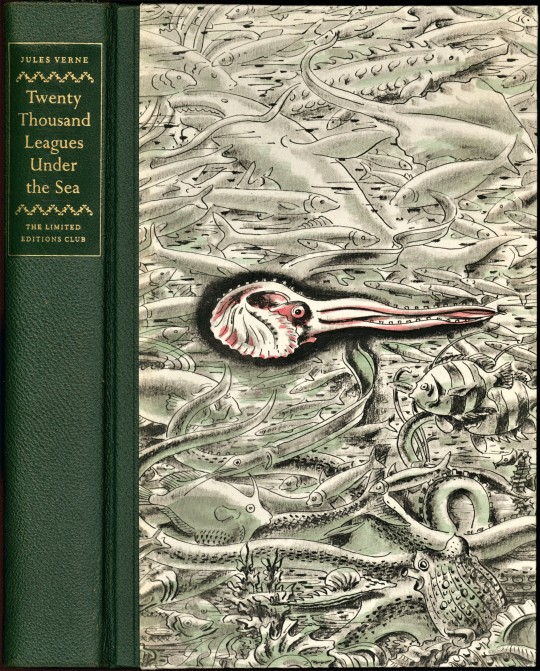


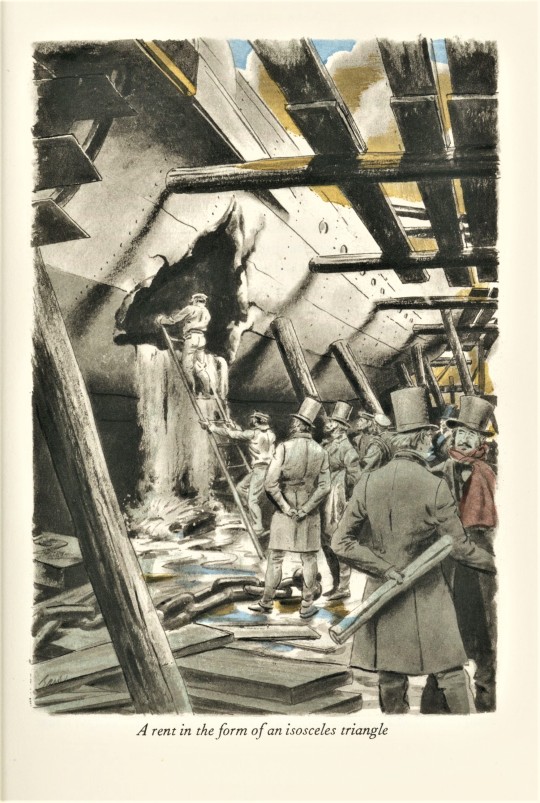




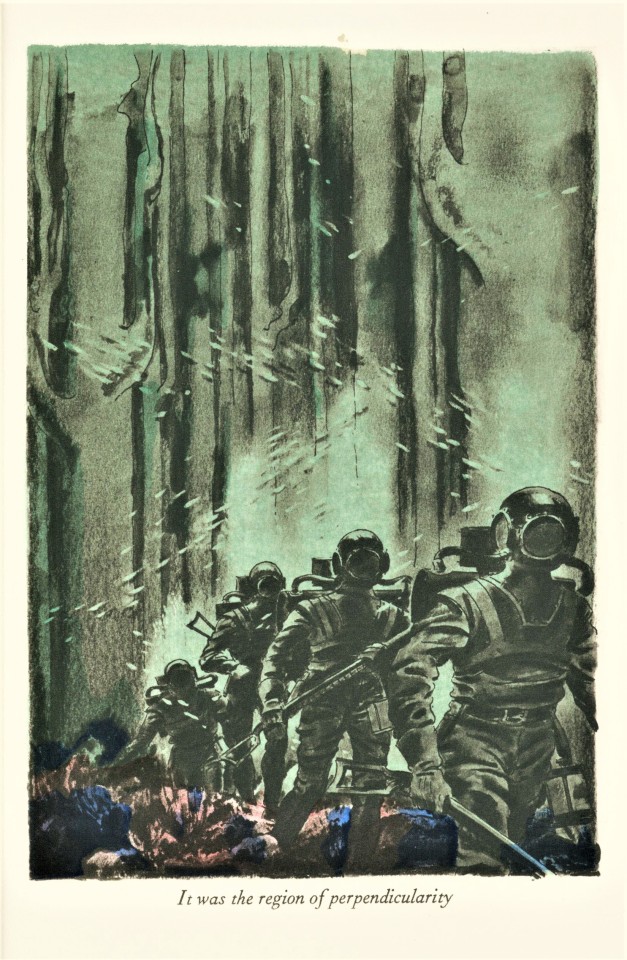
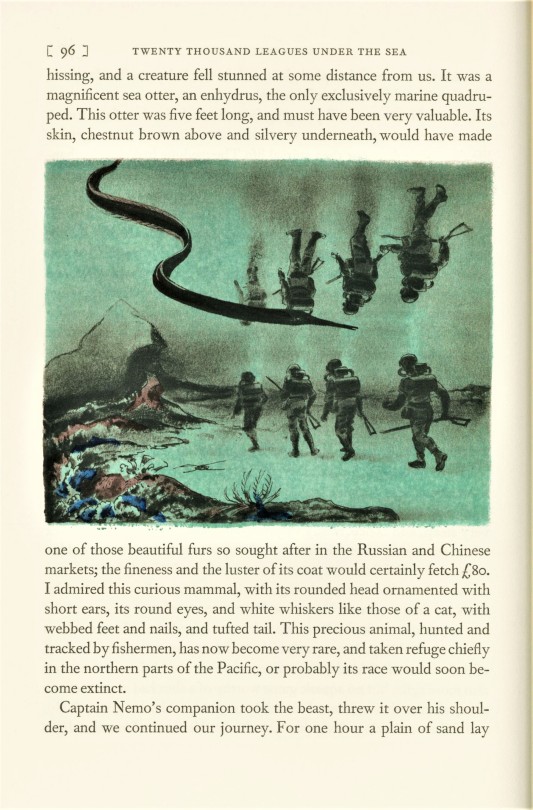
It’s Fine Press Friday!
This week we bring you Twenty Thousand Leagues Under the Sea by Jules Verne, illustrated by Edward A. Wilson, and printed in 1956 for the members of The Limited Editions Club at The Plantin Press in an edition of fifteen-hundred copies signed by the illustrator.
This classic of science fiction adventure novels was first published in a serial format, from March 1869 to June 1870, as part of a Verne’s series called Voyages Extraordinaries, in Magasin d'éducation et de récréation, a magazine founded by the French editor and publisher Pierre-Jules Hetzel. There would be a total of fifty-four novels in this series published during the author’s lifetime, between 1863 and 1905.
This novel is considered to be one of Verne’s greatest works, along with Around the World in Eighty Days and Journey to the Center of the Earth, which are a part of the same series. The books were meant to depict historical and scientific knowledge. In particular, Verne’s descriptions of submarines would turn out to be surprisingly accurate considering the primitive technology that existed at the time he wrote the book.
Once a novel completed its serial release in the magazine, it would be published in book form, typically in three editions, one without illustrations, a second with a few illustrations, and one richly illustrated version in a deluxe octavo format.
The first deluxe edition of Twenty Thousand Leagues Under the Sea was published in November, 1871. Just in time for Christmas shoppers. The French academic painter Alphonse de Neuville and Eduard Riou together produced 111 illustrations for the book. Eduard Riou illustrated six of Jules Verne’s novels.
The tradition continues here, where this text is accompanied by the work of American illustrator, printmaker and commercial artist, Edward A. Wilson. Wilson’s illustrations were transferred and printed in gravure by the Photogravure and Color Company of New Jersey. The gravure’s were then hand colored in the studio of Martha Berrien in New York. The book is quarter bound in green leather and covered with a paper that has been printed with a decorative illustration and hand-colored. The type was set in Monotype Fournier and printed by Saul and Lillian Marks at their Plantin Press in Los Angeles on a paper made especially for this book by the Curtis Paper Company.
Use this link for more Fine Press Friday posts!
Use this link for more Limited Editions Club posts!
Teddy- Special Collections Graduate Intern.



#Fine Press Friday#Fine Press Fridays#juels verne#Edward A. Wilson#edward wilson#Limited Editions Club#twenty thousand leagues under the sea#Voyages Extraordinaries#science fiction#Pierre-Jules Hetzel#Saul and Lillian Marks#photogravures#Photogravure and Color Company#teddy#Martha Berrien#Curtis Paper Company#fine press books#plantin press
125 notes
·
View notes
Text
Films Watched in April 2023
Fargo | Joel Coen / Ethan Coen | 1996
Le plein de super (Fill 'er Up with Super) | Alain Cavalier | 1976
Angel's Egg | Mamoru Oshii | 1985
The Anniversary | Roy Ward Baker / Alvin Rakoff | 1968
Punk Samurai Slash Down | Gakuryû Ishii | 2018
Abel (AKA Voyeur) | Alex van Warmerdam | 1986
Suicide Club | Sion Sono | 2001
Blank Generation | Ulli Lommel | 1980
Behind Her Eyes | TV | Erik Richter Strand | 2021
The Strange Case of the End of Civilization as We Know It | Joseph McGrath | 1977
The Sunday Woman | Luigi Comencini | 1975
Enys Men | Mark Jenkin | 2022
Electric Dragon 80.000 V | Gakuryû Ishii | 2001
La cicatrice intérieure (The Inner Scar) | Philippe Garrel | 1972
Ava | Léa Mysius | 2017
The Fall | TV | Allan Cubitt / Jakob Verbruggen | 2013 - 2016
Films Watched in May 2023
The Devil's Trap | Frantisek Vlácil | 1962
The Week Starts on Friday (Short) | Elmar Klos | 1962
Beauty and the Beast | Juraj Herz | 1978
Frantisek Hrubín (Short) | Tomás Skrdlant | 1964
The People Next Door | David Greene | 1970
Celia | Ann Turner | 1989
Renfield | Chris McKay | 2023
Luminous Procuress | Steven Arnold | 1971
Dragon's Return | Eduard Grecner | 1968
The Man on the Roof | Bo Widerberg | 1976
Coach to Vienna | Karel Kachyna | 1966
She Dies Tomorrow | Amy Seimetz | 2020
Justine | Stewart Mackinnon | 1976
Yakuza Graveyard | Kinji Fukasaku | 1976
The Bride Wore Black | François Truffaut | 1968
The Haunting of Julia | Richard Loncraine | 1977
The End of the F***ing World | TV | Various | 2017-2019
Yellowjackets | Season 2 | TV | Various | 2023
The Cat Creeps | Erle C. Kenton | 1946
Me, Natalie | Fred Coe | 1969
Bold = Top Ten
Some notes: I’ve been going through one of those periods where I just wasn’t feeling it maaaan with regards to films and tumblr. Other things consumed my attention (Auriel's Bow isn't going to fetch itself from the Forgotten Vale) and at times it felt a struggle to watch and post. Still...
Anyway here’s one of those fancy two month Film Logs last seen in August/September 2022 only this time there’s a Top Ten compiled from both months. A few TV things make it into the list. I’m sometimes unsure about putting TV in the *Film* Log but The End of the F***ing World is great and I was very taken with Behind Her Eyes because it actually surprised me in the direction it took, such an unusual experience nowadays, plus the two female leads were very attractive. Hey, I’m only human, like Phil Oakey.
20 notes
·
View notes
Text

“Very early, the young rebel Limonov got into the habit of regarding the dissidence born in the sixties with a mocking hostility, of pretending to put Solzhenitsyn and Brezhnev, Brodsky and Kosygin, all in the same boat: important people, officials, sworn authorities, each pontificating on his own side of the barrier, the first secretary's complete works on dialectical materialism stacked up next to the weighty tomes by the longbeard who plays the prophet. That's not for us astute lumpen punks, who've learned a thing or two and know full well that it's a huge exaggeration to call Soviet society totalitarian: above all it's chaotic, and anyone who's halfway clever can take advantage of the chaos and have a good time.
According to the most serious historians (Robert Conquest, Alec Nove, my mother), twenty million Russians were killed by the Germans during four years of war, and twenty million by their own government during twenty-five years of Stalin's reign. These two figures are approximations, and the sets they cover must intersect somewhat. But what's important for the story I'm telling is that the first profoundly marked Eduard's childhood and adolescence, and he did what he could to ignore the second because, despite his taste for revolt and his disdain for his parents' mediocre destiny, he remains their boy: the son of a subordinate Chekist officer, raised in a family that was spared the major convulsions of history and that, having never experienced absolute arbitrariness, thought that if people were arrested, well then, there had to be a reason. He remains a Young Pioneer who's proud of his country, its victory over the Fritzes, its empire that spans two continents and eleven time zones, and the holy fear it inspires in those Western pansies. He doesn't care about anything, but he cares about that. When people get to talking about the Gulag he sincerely thinks they're exaggerating, and that the intellectuals who denounce it are making a big fuss over something the nonpolitical prisoners (meaning run-of-the-mill gangsters) tend to be much more laid back about. Added to that, the dissidents' boat is full as it is. It's already got its stars; if he joins them he'll never be anything but second fiddle, and fat chance of him accepting that. So he prefers to snicker and say that people like Brodsky are full of themselves, that his banishment to Arkhangel'sk is a nice joke, five years—reduced to three—of vacation in the countryside with the Nobel Prize at the finish line, even if he doesn't know it yet: well done, Captain Levitin!” - Emmanuel Carrère, ‘Limonov: The Outrageous Adventures of the Radical Soviet Poet Who Became a Bum in New York, a Sensation in France, and a Political Antihero in Russia’ (2011) [p. 62, 63]
3 notes
·
View notes
Text
Is it time?
Uh, yeah.
Cool. Now then...
I created this account in 2020, but began posting starting this year. That marked the start of the Singlet Era.
Singlet Era: Newbie Chapter
I had a hard time adapting to this hellsite (affectionate), but I managed it. I had fun with the (at the time) new Polls feature, Vanilla Extract and all. Two months later, the first piece of the way to today was put into place.
Singlet Era: Snom Chapter
On April 14th, I created @i-am-a-green-snom, my first sideblog and my first RP blog. I only used continuously until May 12, after which I returned to the main blog. But it was three months later that the second and most important piece was put into place.
Singlet Era: Punctuation Chapter
On August 8th (our grandma's birthday, coincidentally), I joined the EPPRBCU as @wisdombearingexclam. Fun fact: As Kschwal, of all people, figured out, Wisdom Bearer is, in fact, a reference to the YouTube "gameshow" Ten Words of Wisdom (or TWOW for short), the community for which I was a part of at the time, having hosted 2.5 seasons of a TWOW by then. The colours for Wisdom Bearer's design are actually based off of my booksona's! But that's besides the point.Since then, I made many more EPPRBlogs, which was getting too much for the other EPPRBCU server members. But then on October 17th, while making my 17th EPPRBlog, it all of a sudden became our 17th EPPRBlog. Thus marking the start of the System Era.
System Era
I, Ian, started this system in N.A.E.'s headspace on October 17th. After that, 3 more headmates joined in. I, Alice, joined them on October 20th; I, Carl, joined on the 23rd; and finally, I, Eduard, joined on the 26th.
And then, on the 30th... hiatus. This blog went on a hiatus. The profile picture and banner were changed to a clean #00ffbf, and the blog title and description were changed to "[placeholder]".
It was a great 9 months on gwblwbwlwbl, but now, I, nay, WE welcome you... to hnoc-system.
Enjoy.
Alright, great job, guys. You can go now.
7 notes
·
View notes
Note
character questions for the btaf crew!!! 1, 4, 5, 6, 10
thank youuuuu 💛💛💛 rapid answers gogogogo
1. What motivates your character?
biscella: love
eduard: love (derogatory)
sjaak: love (for better or worse)
azelie: love, defiance
silvano: sadism probably.
luis: the idea of purity (he’s a cult leader p much so take of that what you will)
maritxell: luis’s will
rosita: luis’s will and “love” (derogatory and questionable)
gust: to eradicate vampires from the world by any means necessary (also kinda cult-y)
dalal: gust’s goals by any means necessary
florissa: to stay alive and hopefully escape
4. Does your character care about their reputation and/or how others perceive them?
answered this for some of them (eduard, biscella, sjaak and azelie) but for the rest:
silvano: 2/10
luis: -100000000000000/10
maritxell: 10/10 regarding luis, 0/10 for anyone else
rosita: 6/10
gust: -100000000000000/10
dalal: 9/10 regarding gust, 3/10 for everyone else
florissa: 5/10
5. Is your character more of a family or friends person?
the casavantes (luis, maritxell, rosita, eduard, azelie, and silvano) are are more family people bc they’re p much a vampire cult as ya do. the wolves (gust and dalal) are the same.
biscella cares about both equally.
sjaak cares more about his friends because he has no family.
florissa cares about HER family back home that she’s been taken away from. she has some care for the werewolves around her but not enough to abandon them if she got the chance.
6. What, if anything, sticks out about their appearance?
pain and suffering that you asked this LMAO i still don’t know what these characters look like too hard cuz my brain is kind of focused on making sure they’re somewhat historically accurate as well. However, i’ll give you the current defining characteristics of what they look like or their Vibe for now (which is subject to change)
biscella: dark curly hair, a long narrow nose (think india), tan skinned
eduard: pale asf, red eyes, black hair
sjaak: dark skin, afro-centric features, curly hair.
azelie: black hair, olive skin, pale green eyes
luis: pale asf, red eyes, dirty blonde hair
maritxell: pale asf, red eyes, long dirty blonde hair. scars around her mouth.
rosita: pale asf, red eyes, wavy blonde hair. scars around her mouth
silvano: luis 2.0 but younger looking
gust: he’s always wearing a hood or shroud that hides his face as well as a braided turban
dalal: has her hair covered in a scarf of some kind
florissa: long dark hair, several beauty marks across her face and neck
10. If your character is an antagonist or something of the like, do they self-justify their actions? If so, how?
did this for eduard, sjaak, and azelie, so let’s do the other VILLAINS—
luis: of course he self justifies; he doesn’t believe in god but if he did he himself would be god. what he says goes, and it doesn’t matter if he contradicts himself he’ll kill you if you point it out. he rules the casavantes estate with an iron fist and he has killed for it.
maritxell: all of her actions are deemed acceptable under luis’s command and if they are that’s how she justifies them. it doesn’t matter if they’re right or wrong if luis says, it goes.
rosita: she doesn’t like… self justify in the traditional way. she Knows she’s jealous and angry and that is her justification to herself, but she knows damn well if eduard wasn’t in the crypt she wouldn’t dream of acting this way towards biscella
silvano: he operates on sadistic radical equality. there is no division of the sexes in his mind and to him everyone should be treated as the same: a sack of flesh used to further the cause. it sounds good on paper until you think about what that entails 💀
gust: vampires need to be eradicated for the good of humankind is what he preaches and sure to some extent he may be correct. However, the steps and methods and lengths he uses to get there are questionable and bordering on morally reprehensible; but for the sake of humanity—
dalal: she doesn’t self justify so much as she acknowledges that in order for humanity to be safe she has to get her hands dirty. she, like azelie, is aware that she will have to do bad things to further her goals, but she doesn’t excuse what she’s done. she just hopes that what she does will lead to a good outcome and impact.
3 notes
·
View notes
Text






























Seward’s Day
Seward’s Day, which falls on the last Monday in March and takes place on March 25 this year, is named for then-Secretary of State William H. Seward, who was responsible for the purchase in the first place. This legal holiday (in Alaska) commemorates the day the Alaska Purchase treaty was signed. This day shouldn’t be confused with National Alaska Day, however, which marks the formal transfer of control of Alaska from Russia to the U.S.
HISTORY OF SEWARD’S DAY
A long long time ago — around the 18th century — Alaska was owned by the Russians. Then came the Crimean War. Fought for the rights of Christian minorities in the Holy Land (a part of the Ottoman Empire), Russia fought against the alliance of France, the Ottoman Empire, the United Kingdom, and Sardinia, and lost. Reeling from this, Russian Tsar Alexander II started exploring options to raise money for the country. He turned his gaze towards Alaska. Not only had the sea otter population vastly declined, but Alaska would also prove to be very difficult to defend in the event of a future war. Especially since the British forces were based out of neighboring Canada.
The Russians discussed this plan and were all for selling to the U.S. by 1857, in the hopes that their presence would deter the British from any attacks. Negotiations began; however, the American Civil War took precedence at this time and any plans for buying Alaska were put on hold. Following the Union win, Tsar Alexander asked for another round of negotiations. The U.S. Secretary of State William Seward negotiated with Russian Minister Eduard de Stoeckl. They agreed to a treaty on March 30, 1867, which was ratified by the U.S. Senate. At the time, they paid $7.2 million, or about two cents per acre.
They called this place ‘Alaska,’ changing it from the Russian name, ‘Аляска’ (or ‘Alyaska’). Most Russian citizens went home, barring a few — traders and priests, mostly — who chose to remain. They would eventually leave Alaska too, as records indicate.
The reactions to this purchase were largely positive, with people believing the added possession would create a base to expand trade in Asia. Seward’s political opponents coined the phrase ‘Seward’s Folly’ or ‘Seward’s Icebox,’ referring to Alaska as ‘useless land’’ Alaska would remain sparsely populated until the Klondike Gold Rush of 1896 when the region came to be seen as a truly valuable addition to U.S. territory. Today, Alaska stands as the U.S.’s 49th largest territory and is a booming tourist spot.
SEWARD’S DAY TIMELINE
1741
The European Discovery Of Alaska
A Russian expedition led by Danish explorer Vitus Bering — and including German Zoologist and explorer George Steller — sights Alaska; the land is already inhabited and has been since around 10,000 B.C., as per historical records.
1867
Re-negotiations
Russia enters into re-negotiations with the U.S. to sell Alaska; they approached America with this plan before the Civil War too.
1867
The Treaty Is Signed
William Seward and Russian Minister Eduard de Stoeckl agree on a treaty for the purchase of Alaska, which is signed at 04:00 on March 30.
1867
The Transfer
Alaska's ownership transfers from Russia to the U.S.; the Russian flag is lowered and the U.S. flag takes its place as American soldiers parade in front of the governor's house.
1959
We Have A State
Originally called the 'Department of Alaska,' the name changes to 'District of Alaska' (1884), then the 'Alaska Territory' (1912), before being admitted as a state in the U.S.; it gains the name 'State of Alaska'.
SEWARD’S DAY FAQS
What is Seward's Day in Alaska?
The last Monday in March is celebrated as Seward’s Day and commemorates the signing of the Alaska Purchase Treaty.
Why is Alaska Day celebrated?
Alaska Day celebrates the formal transfer of the territory of Alaska from Russia to the U.S. This event took place on October 18, 1867.
Is there school on Seward's Day in Alaska?
Seward’s Day is a paid holiday, so all state employees, all state, county, and city government offices, along with most schools and libraries, will close. Private businesses can close at their own discretion.
HOW TO OBSERVE SEWARD’S DAY
Read up on William SewardOn this day named after this guy, we recommend doing a little light reading on who he was and how he came to be in politics. It’s bound to be a fascinating story.
Watch a special about AlaskaOn Seward's Day, multiple channels air history programs about different facets of this state. Put on your favorite one or find a special documentary you want to watch, and settle down for some fun, educational screen time.
Learn more about the transferDid you know more than 150 years on, some Russians still have second thoughts about the sale? Find out more facts like these by digging into documents and articles centering on Alaska's transfer.
5 FACTS YOU DIDN'T KNOW ABOUT JOHN SEWARD
He was an abolitionist: Seward was a dedicated opponent to slavery and was a prominent member of the Republican Party in its formative years.
A house with a secret: Seward's home in Auburn, New York, formed part of the Underground Railroad and was apparently a well-regarded stop; the kitchen was one of its most popular stops, quoted an 1891 article in the “Auburn Herald.”
The unseen fruits of his efforts: Seward did not live to see his efforts to purchase Alaska turn very profitable; he died in 1872 before his foresight was commemorated as a legal holiday.
His efforts led to many memorials: These are found in Alaska and all over the U.S. — Seward Park in Seattle, Washington, the City of Seward in Alaska, and a figure of Seward in Ketchikan, Alaska.
He was almost assassinated: He was one of the targets of the 1865 assassination that killed Lincoln; he sustained grievous injuries, which took a long time to heal.
WHY SEWARD’S DAY IS IMPORTANT
We love Alaska: There’s the land, the weather, even the moose. Who doesn't love this place?
It was the best bargain ever! Sure, it might not have seemed like it at the time to some people. However, Seward knew a good deal when he heard one.
It's all about tenacity: Russians exhibited this tendency by coming back to the U.S. with their deal, and Seward stayed steadfast during the purchase, despite the detractors. The purchase, and Alaska's sheer magnificence, show us determination (and patience) does, indeed, reap rewards and influence change.
Source
#last Monday in March#25 March 2024#Seward’s Day#original photography#vacation#tourist attraction#landmark#clouds#nature#summer 2023#flora#travel#landscape#forest#woods#countryside#cityscape#architecture#USA#West Coast#Last Frontier#Coast Mountains#Alaska#Klondike Highway#the North#blue sky#Skagway#small town#street scene
2 notes
·
View notes
Text
Selvadorada Liberated, Princess Missing!

In a rescue and liberation invasion early last night, the combined Simsdom, Newcrest, and nearby Brindleton forces landed on the beach in Selvadorada, infiltrating the occupied royal villa, and arresting the Windenburgian forces.

Lower ranking Windenburg soldiers were rounded up from all the villages, and are being transported to Brindleton, where the dorms of the Brindleton University have been converted to hold PoWs until the end of war. Higher ranking officers and leaders have been boarded onto ships to be taken to Glimmerbrooke, where they will be housed at an undisclosed location for their protection. The allied force that liberated Selvadorada has been tasked with staying behind to protect it from further Windenburgian raids, and to help the smaller villages get back to normal as quickly as possible.


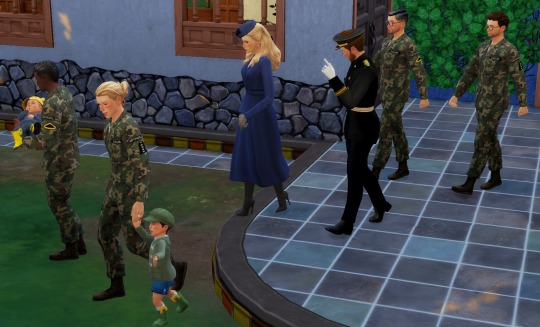
Among those in leadership that were arrested last night include Lucien and Felicity Castellano, Lord and Lady Frankvan in Windenburg, and their two young sons. Reports say Lady Frankvan will not be separated from her sons where she will be housed in the Empire, but Lord Frankvan will be held elsewhere for questioning.

Lord Frankvan was expectedly incredibly angry at having lost his powerful position, and seemed to be taking all of that anger out on his wife, who, to us, looked positively done and refused to acknowledge him, focusing all of her attention on her two sons, being escorted ahead of them by Imperial Soldiers.


(The young Castellanos- Otto, left, and Oskar, right- being led to the Imperial ships that will take them to Glimmerbrooke)
The invasion was not as easy as it all seems, however, and there were some losses sustained. The most recognizable names include Eduard Humphrey, Earl of Sawborne in Newcrest, serving as a colonel in the Imperial army...
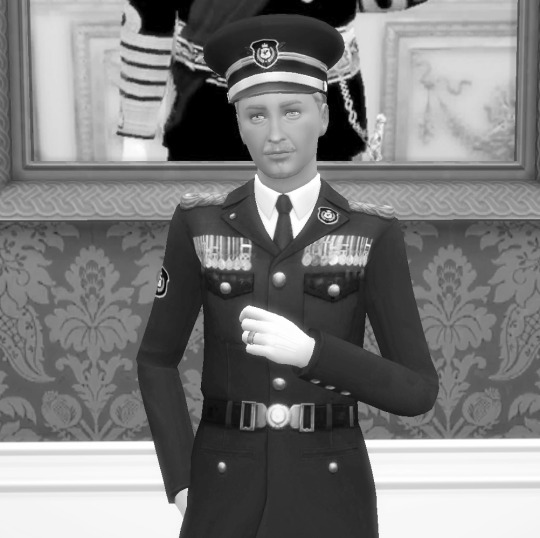
(Earl Eduard Humphrey of Sawborne)
...and His Royal Highness, Prince Consort Rauli of Selvadorada. HRH is reported to have jumped in front of a danger that was about to harm his wife, Queen Anaid, and son, Crown Prince Ramses, when the Windenburgian forces attempted to retaliate against their hostages during the invasion. Unfortunately, Simsdom Medical Soldiers were unable to reach the Prince in time...




(HRH Prince Consort Rauli Montero of Selvadorada)
... and finally, HIH Princess Rosalind Ivanov, fiancee to the Crown Prince, along with her lady's maid and secretary, Lady Itzel Aguilar, and Windenburgian officer, Viscount Giovanni Castellano of Foreker, are all unaccounted for. Lord Foreker is the younger brother of Lord Frankvan, and both are high ranking officers in the Windenburgian Military, so many are worried that His Lordship kidnapped the Princess to use for ransom when he saw things going downhill during the invasion. Imperial forces have begun a search and rescue mission into the jungles of Selvadorada, but the terrain is difficult to transverse, so the mission is moving slowly.


(Princess Rosalind Ivanov, left, Lady Itzel Aguilar, no picture available, and Viscount Giovanni Castellano, right, all marked as missing. Rescue efforts are in progress)
Our condolences go out to the families who lost someone on this mission, and our best of luck towards finding the missing Princess. Overall, however, the Empire considers this a win- recovering Sovereignty for Selvadorada and restoring the Royal Family back to power, as well as capturing a high ranking Windenburg officer to who may be able to provide intell.
6 notes
·
View notes